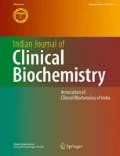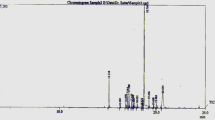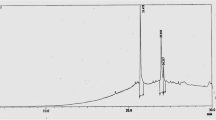Abstract
The identification and pharmacological validation of plant-based lead compounds for the cure of different diseases including cancer have always been globally strived. In addition to possessing numerous medicinal properties, many of the phytochemicals display antioxidant potential activities. Reactive oxygen species (ROS) causeoxidative stress leading to several severe diseases such as cancer. The antioxidants are substances that fight against ROS to protect the cells from their damaging effects. In the present study, the effects of methanol extract of Euglena tuba(ETME) have been evaluated for its antioxidant and antitumor potential against Dalton’s lymphoma (DL) introduced in BALB/cmice. After 24 h of intraperitoneal inoculation of DL cells in mice, ETME (300 mg kg−1 body weight) was administered intraperitoneally upto18 alternative days. On the 18th day, the mice were sacrificed; the blood and tissues (liver and brain) were collected to determine the tumor growth parameters including morphological, behavioural, haematological profile, and antioxidant indices. The results indicated that ETME exhibited significant antioxidative and antitumor properties when compared with the data from DL bearing mice. The results from the present study indicated that ETME contained remarkable antitumor efficacy, which was mediated through amelioration of oxidative stress. The data suggested that ETME could be used as a potential natural anticancer agent.


Similar content being viewed by others
References
Meiyanto E, Hermawan A, Anindyajati A. Natural products for cancer targeted therapy: citrus flavonoids as potent chemopreventive agents. Asian Pac J Cancer Prev. 2012;13:427–36.
Muthumani P, Venkatraman S, Ramseshu K, Meera V, Devi R, Kameswari P et al. Pharmacological studies of anticancer, anti-inflammatory activities of Murrayakoenigii (Linn) Spreng in experimental animals C/I. J Pharmaceutical Sci Res 2009;3137–3141.
Gennari CD, Castoldi D, Sharon O. Natural products with taxol-like anti tumour activity: synthetic approaches to elutherobin and dictyostatin. Pure Appl Chem. 2007;79(2):173–80.
Pawlowska N, Gornowicz A, Bielawska A, Surazynski A, Szymanowska A, Czarnomysy R et al. The molecular mechanism of anticancer action of novel octahydropyrazino[2, Invest New Drugs 1a:5,4-a] diisoquinoline derivatives in human gastric cancer cells. Invest New Drugs 2018;36:970984.
Mantindale JL, Holbrook NJ. Cellular response to oxidative stress: signaling for suicide and survival. J Cell Physiol. 2002;192:1–15.
Wang J, Yi J. Cancer cell killing via ROS: to increase or decrease, that is the question. Cancer Biol Ther. 2008;12:1875–84.
Lee SH, Kang HJ, Lee HJ, Kang MH, Park YK. Six-week supplementation with Chlorella has favorable impact on antioxidant status in Korean male smokers. Nutrition. 2010;26:175–83.
Kubatka P, Kapinov A, Kruzliak P, Kello M, Vybohova D, Kajo K. Antineoplastic effect of microalga Chlorella pyrenoidosain the breast cancer model. Nutrition. 2015;31:560–9.
Sreenivas SA, Venu Gopal Y, Ravidranath A, Kalpana G, Kapoor R. Anti-tumour and antioxidant activity of Capparis Sepiaria against Dalton’s ascites lymphoma in rodents. Acad J Cancer Res. 2012;5:46–52.
Lofti Jam K, Carey M, Jefford M, Schofield P, Charleson C, Aranda S. Nonpharmacologic strategies for managing common therapy adverse effects: a systematic review. J Clin Oncol. 2008;26:5618–29.
Kunnumakra AB, Asheef M, Babu BH, Padikkala J. The inhibition of gastric mucosal injury by Punicagranatum L. (pomegranate) methanolic extract. J Ethnopharmacol. 2005;96:171–6.
Kuete V, Efferth T. Cameroonian medicinal plants: pharmacology and derived natural products. Front Pharmacol. 2010;1:123.
Anand P, Kunnumakara AB, Sundaram C, Harikumar KB, Tharakan ST, Lai OS. Cancer is a preventable disease that requires major life style changes. Pharm Res. 2008;25:2097–116.
Amin A, Gali-Muhtasib H, Ocker M, Schneider-Stock R. Overview of major classes of plant- derived anticancer drugs. Int J Biomed Res. 2009;5:1–11.
Balunas MJ, Kinghorn AD. Drug discovery from medicinal plants. Life Sci. 2005;78:431–41.
Khan MA. Euglenoid Red-bloom contributing to the Environmental Pollution of Dal Lake. Kashmir Himalaya Environ Conserv. 1993;20:352–6.
Abalde J, Fabregas J. Herrero C: β-Carotene, vitamin C, vitamin E content of the marine microalga Dunaliellatertiolecta cultured with different nitrogen source. BioresTechnol. 1991;38:121–5.
Dillon JC, Phan PA. Spirulina source of protein in human nutrition. Bull Inst Oceanol. 1993;12:103–7.
Dudonne S, Vitrac S, Coutiere P, Woillez M, Merillon JM. Comparative study of antioxidant properties and total phenolic content of 30 plant extracts of industrial interest using DPPH, ABTS, FRAP, SOD and ORAC assays. J Agric Food Chem. 2009;57:1768–74.
Barahona T, Chandia NP, Encinas MV, Matsuhiro B, Zuniga EA. Antioxidant capacity of sulfated polysaccharides from seaweed: a kinetic approach. Food Hydrocoll. 2011;25:529–35.
Takeyama H, Kanamaru A, Yoshimo Y, Katuta H, Kawamura Y, Matsunaga T. Production of antioxidant vitamins, beta-carotene, vitamin C, and vitamin E, by two step culture of Euglena gracilis Z. Biotechnol Bioeng. 1997;53:185–90.
Kondo Y, Kato A, HojoH NS, Takeuchi M, Ochi K. Cytokine-related immunopotentiating activities of paramylon, a ß-(1,3)-d-glucan from Euglena gracilis. J Pharmacobio Dyn. 1992;15:617–21.
Foltinova P, Lahitova N, Ebringer L. Antimutagenicity in Euglena gracilis. Mutat Res. 1994;323:167–71.
Das BK, Pradhan J, Pattnaik P, Samantaray BR, Samal SK. Production of antibacterials from the freshwater alga Euglena viridis (Ehren). World J Microbiol Biotechnol. 2005;21:45–50.
Nakashima H, Ohshiro Y, Miyano N, Yamamoto N, Ichikawa S, Kondo H, et al. Synergistic inhibition of hundoman immunodeficiency virus type 1 (HIV-1) replication in vitro by sulphated paramylon and 3′-azido-2′,3′- dideoxythymidine (AZT). Lett Appl Microbiol. 2008;18:24–6.
Watanabe T, Shimada R, Matsuyama A, Yuasa M, Sawamura H, Yoshida E. Antitumor activity of theb-glucan paramylon from Euglena against preneoplastic colonic aberrant crypt foci in mice. Food Funct. 2013;4:1685–90.
Wahome PG, Beauchesne KR, Pedone AC, Cavanagh J, Melander C, Zimba P. Augmenting anti-cancer natural products with a small molecule adjuvant. Mar Drugs. 2015;13:65–75.
Percival M: Antioxidants. Clin Nutr 1998 Insight nut 031 1/96 rev. 10/98.
Hermans N, Cos P, Maes L, Bruyne TD, Berghe DV, Vlietinck AJ. Challenges and pitfalls in antioxidant research. Curr Med Chem. 2007;14:417–30.
Latham H. Temperature stress-induced bleaching of the coralline alga Corallina officinalis: a role for the enzyme bromoperoxidase. Biosci Horizon. 2008;1:104–13.
Kusmic C, Barsacchi R, Barsanti L, Gualtieri P, Passarelli V. Euglena gracilis as a source of the antioxidant vitamin E. Effects of culture conditions in the wild strain and in the natural mutant WZSL. J Appl Phycol. 1999;10:555–9.
Kumar et al. Quantitative analysis and first report of Euglena tuba from Himachal Pradesh, India, IJSR 2016;5:(12).
Das BK, Pradhan J, Pattnaik P, Samantaray BR, Samal SK. Production of antibacterials from the freshwater alga Euglena viridis (Ehren). World J MicrobiolBiotechnol. 2005;21:45–50.
Panja, et al. Phytochemical profile of a microalgae Euglena tuba and its hepatoprotective effect against iron-induced liver damage in swiss albino mice. J Appl Microbiol. 2014;117:1773–86.
Choudhury B, Kandimalla R, Bharali R, Monisha J, Kunnumakara AB, Kalita K. Anticancer activity of garcinia morella on t-cell murine lymphoma via apoptotic induction. Front Pharmacol. 2016;29(7):3.
Bedi O, Krishan P. Investigations on acute oral toxicity studies of purpurin by application of OECD guideline 423 in rodents Naunyn-Schmiedeberg’s. Arch Pharmacol. 2020;393:565–71.
Niehaus WG Jr, Samuelsson B. Formation of malonaldehyde from phospholipid arachidonate during microsomal lipid peroxidation. Eur J Biochem. 1968;6(1):126–30.
Sedlak J, Lindsay RH. Estimation of total, protein bound, and nonprotein sulfhydryl groups in tissue with Ellman’s reagent. Anal Biochem. 1968;25(1):192–205.
Marklund S, Marklund G. Involvement of the superoxide anion radical in the autoxidation of pyrogallol and a convenient assay for superoxide dismutase. Eur J Biochem. 1974;47(3):469–74.
Beers RF Jr, Sizer IW. A spectrophotometric method for measuring the breakdown of hydrogen peroxide by catalase. J Biol Chem. 1952;195(1):133–40.
Horecker BL, Kornberg A. The extinction coefficient of the reduced band of pyridine nucleotides. J Biol Chem. 1948;175:385–90.
Lowry OH, Rosebrough NJ, Farr AL, Randel RJ. Protein measurement with folin-phenol reagent. J Biol Chem. 1951;193(1):265–75.
Ferdous UT, Yusof ZNB. Medicinal prospects of antioxidants from algal sources in cancer therapy. Front Pharmacol 2021.
Battisti V, Maders LDK, Bagatini MD, Santos KF, Spanevello RM, Maldonado PA. Measurement of oxidative stress and antioxidant status in acute lymphoblastic leukaemia patients. J Clin Biochem. 2008;41:511–8.
Navarro J, Obrador E, Pellicer JA, Asensi M, Vina J, Estrela JM. Blood glutathione as an index of radiation-induced oxidative stress in mice and humans. Free Radic Biol Med. 1997;22:1203–9.
Curatolo P, Bombardieri R, Jozwiak S. Tuberous sclerosis. Lancet. 2008;372(9639):657–68.
Stewart CL, Warner S, Ito K, Raoof M, Wu GX, Kessler J. Cytoreduction for colorectal metastases: liver, lung, peritoneum, lymph nodes, bone, brain. When does it palliate, prolong survival, and potentially cure? Curr Probl Surg. 2018;55(9):330–79.
Bergendi L, Benes L, Durackova Z, Ferencik M. Chemistry, physiology and pathology of free radicals. Free Radical Chemistry, Physiology and Pathology1999;65 Nos. 18/19,1865–1874.
Asirvatham R, Akhil J, et al. Evaluation of in vitro and in vivo anti- oxidant potential of Morinda reticulata GAMBLE tubers in Wistar albino rats subjected to CCl4 and paracetamol induced hepatotoxicity. Indonesian J Phar. 2017;28(3):147–57.
Oberley TD. Oxidative damage and cancer. Am J Pathol. 2002;160:2.
Pikula KS, Zakharenko AM, Aruoja V, Golokhvast KS, Tsatsakis AM. Oxidative stress and its biomarkers in microalgal ecotoxicology. Current Opin Toxicol. 2019;13:8–15.
Rezayian M, Niknam V, Ebrahimzadeh H.Oxidative damage and antioxidative system in algae, Toxicol Rep 2019;1309–13131310.
Valenzuela A. The biological significance of malondialdehyde determination in the assessment of tissue oxidative stress. LifeSci. 1990;48:301–9.
Balendiran GK, Dabur R, Fraser D. The role of glutathione in cancer. Cell BiochemFunct. 2004;22(6):343–52.
Bhattacharya S, Prasanna A, Majumdar P, Kumar RBS, Haldar PK. Antitumor efficacy and amelioration of oxidative stress by Trichosanthes dioica root against Ehrlich ascites carcinoma in mice. Pharm Biol. 2011;49(9):927–35.
Oberleyll TD, Oberlef LW. Antioxidant enzyme levels in cancer. Histol Histopathol. 1997;12:525–35.
Senousy HH, Abd Ellatif S, Ali S. Assessment of the antioxidant and anticancer potential of different isolated strains of cyanobacteria and microalgae from soil and agriculture drain water. Environ Sci Pollut Res. 2020;27:18463–74.
Mujeeb MA, Vedamurthy A, Shettar AK, Puranik SI, Ghagane S, Thimmappa SC. In vitro antioxidant and anticancer activity of tetradesmus acuminatus microalgae extract on MCF-7 human breast cancer cell line. Int J Cancer Res. 2020;16(1):1–9.
Saadaoui I, Rasheed R, Abdulrahman N, Bounnit T, Cherif M, Al JH. Algae-derived bioactive compounds with anti-lung cancer potential. MarineDrugs. 2020;18:197.
Abd El-Hacka ME, Abdelnourb S, Alagawanya M, Abdoc M, Sakrd MA, Khafagae AF. Microalgae in modern cancer therapy: Current knowledge: Biomed Pharmacotherapy 2019;42–50.
Khan T, Ali M, Khan A, Nisar P. Ahmad jan S, Afridi S, Anticancer plants: A review of the active phytochemicals, applications in animal models, and regulatory aspects. Biomolecules. 2020;10(1):47.
Flores A, Sandoval-Gonzalez S, Takahashi R, Krall A, Sathe L, Wei L. Increased lactate dehydrogenase activity is dispensible in squamous carcinoma cells of origin. Nature Communications volume 2019; 10artcle no.91.
Forkasiewicz A, Dorociak M, Stach K, Szelachowski P, Tabola R, Augoff K. The usefulness of lactate dehydrogenase measurements in current oncological practice. Cell Mol Biol Lett. 2020;9:25–35.
Wilpe SV, KoornstraR ,Brok MD , De Groot JW , Blank C , De Vries J. Lactate dehydrogenase: a marker of diminished antitumor immunity, Oncoimmunology 2020;9(1) e1731942:11.
Langeswaran K, Kumar S, Gavaskar S. Antioxidant, anti-microbial and anti-cancer effectiveness of marine macro alga Ulva fasciataDelile. Biomed Res. 2019;30(4):617–27.
Choudhury B, Kandimalla R, Bharali R, Monisha J, Kunnumakara AB, Kalita K. Anticancer activity of Garcinia Morella on T-cell murine lymphoma via apoptotic induction. Front Pharmacol. 2016;7:3.
Naik AV, Dessai SN, Sellappan K. Antitumour activity of Annona muricata L. leaf methanol extracts against Ehrlich Ascites Carcinoma and Dalton’s Lymphoma Ascites mediated tumours in Swiss albino mice. Libyan J Med. 2020;16:1846862.
Sakthivel KM, Kokilavani K, Kathirvelan C, Brindhaa D. Malvidin abrogates oxidative stress and inflammatory mediators to inhibit solid and ascitic tumor development in mice. J Environ Pathol Toxicol Oncol. 2020;39(3):247–60.
Irulappan M, Sriram, Kanth SBM, Kalishwaralal K, Gurunathan S. Antitumor activity of silver nanoparticles in Dalton’s lymphoma ascites tumor model. Int J Nanomed 2010;5:753–762.
Hashem MA, Shoeeb SBA, Abd-Elhakim YM, Mohamed WAM. The antitumor activity of Arthrospira platensis and/or cisplatin in a murine model of Ehrlich ascites carcinoma with hematinic and hepato-renal protective action. J Funct Foods. 2020;66:103831.
Hogland HC. Hematological complication of cancer chemotherapy. Semin Oncol. 1982;9:95–102.
Natesan S, Badami S, Dongre SH, Godavarthi A. antitumor activity and antioxidant status of the methanol extract of Careya arbora bark against Dalton’s lymphoma ascites- induced ascitic and solid tumor in mice. J Pharmacol Sci 2007; 12–23.
Hemamalini SGL, Bhargav A, Vasireddy U. In-vivo anticancer activity of tabebuia rosea (bertol) Dc. Leaves on Dalton’s ascetic lymphoma in mice. IJPSR. 2012;3(11):4496–502.
Pop S, Enciu AM, Tarcomnicu I, Gille E, Tanase C. Phytochemicals in cancer prevention: modulating epigenetic alterations of DNA methylation. Phytochem Rev. 2019;18:1005–24.
Choudhari AS, Mandave PC, Deshpande M, Ranjekar P, Prakash O. Phytochemicals in Cancer Treatment: From Preclinical Studies to Clinical Practice. Front Pharmacol 2020.
Delwatta SL, Gunatilake M, Baumans V, Melanie D, Seneviratne MD, Manjula LB. Reference values for selected hematological, biochemical and physiological parameters of Sprague-Dawley rats at the Animal House, Faculty of Medicine, University of Colombo, Sri Lanka. Animal Model Exp Med. 2018;1:250–4.
Koh Y-C, Ho C-T, Pan M-H. Recent advances in cancer chemoprevention withphytochemicals. J Food Drug Anal. 2020;28:14–37.
Author information
Authors and Affiliations
Corresponding author
Ethics declarations
Conflicts of Interest
The authors do not have any conflict of interest.
Research involving human participants and/or animals
BALB/c mice were used.
Informed consent
Not applicable.
Additional information
Publisher's Note
Springer Nature remains neutral with regard to jurisdictional claims in published maps and institutional affiliations.
Rights and permissions
About this article
Cite this article
Gupta, S.P., Tiwari, P. & Sharma, B. Protective Effect of Methanolic Extract of Euglena tuba Against Dalton Lymphoma Induced Oxidative Stress in BALB/c Mice. Ind J Clin Biochem 37, 410–422 (2022). https://doi.org/10.1007/s12291-021-01011-x
Received:
Accepted:
Published:
Issue Date:
DOI: https://doi.org/10.1007/s12291-021-01011-x




